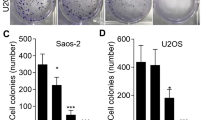Abstract
Osteosarcoma cancer is one of the most lethal malignancies, and there is no effective preventive measure to date. Chamaejasmine is the major ingredient in Stellera chamaejasme L. Except its potent pain-relieving efficacy as reported, chamaejasmine also exerted its anti-tumor activity in several tumor models. Here, we reported that chamaejasmine had a profound anti-proliferative effect on human osteosarcoma cells in a concentration-dependent and time-dependent manner, which was associated with an increase of p21 and bax and a decrease of bcl-2 and consequently increased caspase-3 activity. The main mechanism of anti-tumor potency was mainly attributed to the induction of p53. Chamaejasmine hugely elevated the expression of p53. The results of p53 shRNA experiment further demonstrated that p53 knockdown severely impaired the sensitivity of tested cells to chamaejasmine, implicating the important role of p53 played in chamaejasmine’s anti-tumor activity. In conclusion, results showed chamaejasmine induced apoptosis in MG63 cells and could be a candidate drug for osteosarcoma cancer chemoprevention.





Similar content being viewed by others
References
Hegyi M, Semsei AF, Jakab Z, Antal I, Kiss J, Szendroi M, et al. Good prognosis of localized osteosarcoma in young patients treated with limb-salvage surgery and chemotherapy. Pediatr Blood Cancer. 2011;57(3):415–22.
Jaffe N. Osteosarcoma: review of the past, impact on the future. Cancer Treat Res. 2009;152:239–62.
Ferguson WS, Goorin AM. Current treatment of osteosarcoma. Cancer Invest. 2001;19:292–315.
Bacci G, Lari S. Adjuvant and neoadjuvant chemotherapy in osteosarcoma. Chir Organi Mov. 2001;86:253–68.
Biermann JS, Baker LH. The future of sarcoma treatment. Semin Oncol. 1997;24:592–7.
La Quaglia MP. Osteosarcoma. Specific tumor management and results. Chest Surg Clin N Am. 1998;8:77–95.
Ma QG, Liu WZ, Wu HM, Zhou TX, Qin GW. Phytochemistry. 1997;44:663–6.
Che CT, Ma QG, Qin GW, Williams ID, Wu HM. Phytochemistry. 1999;52:117–21.
Lee SH, Tanaka T, Nonaka GI, Nishioka I, Zhang B. Phytochemistry. 1991;30:1251–3.
Tu SJ, Wang P, Wei A. Chin J Integr Trad West Med. 1984;4:46–7.
Marina N, Gebhardt M, Teot L, Gorlick R. Biology and therapeutic advances for pediatric osteosarcoma. Oncologist. 2004;9:422–41.
Papagelopoulos PJ, Galanis EC, Vlastou C, Nikiforidis PA, Vlamis JA, Boscainos PJ, et al. Current concepts in the evaluation and treatment of osteosarcoma. Orthopedics. 2000;23:858–67.
Yang C, Ji D, Weinstein EJ, Choy E, Hornicek FJ, Wood KB, et al. The kinase Mirk is a potential therapeutic target in osteosarcoma. Carcinogenesis. 2010;31:552–8.
Los M, De Craen MV, Penning LC, Schenk H, Westendorp M, Baeuerle PA, et al. Schulze-Osthoff, requirement of an ICE/CED-3 protease for Fas/APO-1-mediated apoptosis. Nature. 1995;375:81–3.
Nicholson DW, Ali A, Thornberry NA, Vaillancourt JP, Ding CK, Gallant M, et al. Identification and inhibition of the ICE/CED-3 protease necessary for mammalian apoptosis. Nature. 1995;376(6535):37–43.
Petros AM, Olejniczak ET, Fesik SW. Structural biology of the Bcl-2 family of proteins. Biochim Biophys Acta. 2004;1644:83–94.
Enneking WF, Springfield DS. Osteosarcoma. Orthop Clin North Am. 1977;8:785–803.
Delling G. Diagnosis of bone tumors. Verh Dtsch Ges Pathol. 1998;82:121–32.
Federman N, Bernthal N, Eilber FC, Tap WD. The multidisciplinary management of osteosarcoma. Curr Treat Options Oncol. 2009;10:82–93.
Wang Y, Zhao Y, Liu Y, Tian L, Jin D. Chamaejasmine inactivates Akt to trigger apoptosis in human HEp-2 larynx carcinoma cells. Molecules. 2011;16:8152–64.
Fang W, Liu S, Nie Y. Anticancer activity of chamaejasmine: effect on tubulin protein. Molecules. 2011;16:6243–54.
Cooper JD, Michaelidis TM, Tzimagiorgis GZ, Sendtner M, Meyer M, Thoenen H. Cholinergic neuron-specific overexpression of Bax in ChAT Bax transgenic mice. Soc Neurosci Abstr. 1996;22:570.
Kobayashi T, Ruan S, Clodi K, Kliche KO, Shiku H, Andreeff M, et al. Overexpression of Bax gene sensitizes K562 erythroleukemia cells to apoptosis induced by selective chemotherapeutic agents. Oncogene. 1998;16:1587–91.
Cmielová J, Rezáčová M. p21Cip1/Waf1 protein and its function based on a subcellular localization. J Cell Biochem. 2011;112(12):3502–6.
Liu WK, Cheung FW, Liu BP, Li C, Ye W, Che CT. Involvement of p21 and FasL in induction of cell cycle arrest and apoptosis by neochamaejasmin a in human prostate LNCaP cancer cells. J Nat Prod. 2008;71:842–6.
Zhang T, Yu H, Dong G, Cai L, Bai Y. Chamaejasmine arrests cell cycle, induces apoptosis and inhibits nuclear NF-κB translocation in the human breast cancer cell line MDA-MB-231. Molecules. 2013;18:845–58.
Yu H, Zhang T, Cai L, Qu Y, Hu S, Dong G, et al. Chamaejasmine induces apoptosis in human lung adenocarcinoma A549 cells through a Ros-mediated mitochondrial pathway. Molecules. 2011;16:8165–80.
Author information
Authors and Affiliations
Corresponding author
Rights and permissions
About this article
Cite this article
Yang, D., Wang, P. & Ren, X. Apoptosis induced by chamaejasmine in human osteosarcoma cells through p53 pathway. Tumor Biol. 36, 5433–5439 (2015). https://doi.org/10.1007/s13277-015-3209-5
Received:
Accepted:
Published:
Issue Date:
DOI: https://doi.org/10.1007/s13277-015-3209-5




